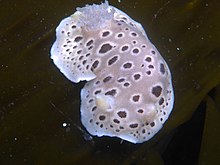en
names in breadcrumbs


Diaulula odonoghuei, the spotted leopard dorid, is a species of dorid nudibranch found in the Pacific Ocean.[1][2] Identified as a cryptic species in 2016,[3] it is differentiated from its sister species Diaulula sandiegensis by having considerably more spots on their mantle.[3]
This nudibranch grows to about 100 mm (4") in length[1] with many spots covering its mantle, this pattern can extend all the way to the edge of the mantle, a defining characteristic of this cryptic species[3]
This dorid nudibranch ranges from the sea of Japan to northern California.[3]
This species feeds on sponges.
 Diaulula odonoghuei from Patrick's Point, CA
Diaulula odonoghuei from Patrick's Point, CA Diaulula odonoghuei, the spotted leopard dorid, is a species of dorid nudibranch found in the Pacific Ocean. Identified as a cryptic species in 2016, it is differentiated from its sister species Diaulula sandiegensis by having considerably more spots on their mantle.